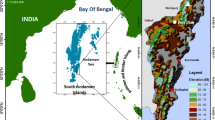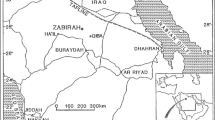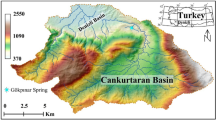Abstract
Khuff Formation is of utmost importance in Saudi Arabia for oil and gas reservoir although it is composed mainly of limestone. This reason refers to the existence of intensive fractures which play a vital role in the increase in porosity and permeability of this formation. The fracture pattern in the study area was verified through 2D and 3D ground penetrating radar (GPR)-defined and electrical resistivity tomography (ERT)-defined surveys. In this respect, ten of 2D GPR surveys were collected along an intersected grid of profiles covering the study area while ERT data were collected along three profiles of the GPR grid. The results were interpreted in light of the field-based structural and stratigraphic assessment of the outcropping rocks. The analysis of the inverted ERT and filtered GPR sections revealed the presence of fractures. Several resistivity and electromagnetic reflection anomalies were laterally and vertically identified across the measured sections clarifying fractures that extend to a depth of 24 m in the limestone. Most fractures are oriented vertical to sub-vertical dipping both east-west and north-south.












Similar content being viewed by others
References
Al Aswad A, Kamel S (1992) Late Permian microfossils from the Khuff Formation, southern Saudi Arabia. In: Abstract in The first International Conference on Geology of the Arab World. January, 18-22. Cairo Univ. 148 p
Al-Jallal IA (1995) The Khuff Formation: its regional reservoir potential in Saudi Arabia and other Gulf countries. In: Al-Husseini, MI (Ed.), The Middle East Petroleum Geosciences, vol. 1. Geo’94, Gulf PetroLink, Bahrain, p 103–119
Amthor J, Friedman G (1991) Dolomite-rock textures and secondary porosity development in Ellenburger Group carbonates (Lower Ordovician), west Texas and southeastern New Mexico. Sedimentology 38:343–362
Bohidar R, Hermance J (2002) The GPR refraction method. Geophysics 67:1474–1485
Chávez RE, Cifuentes-Nava G, Tejero A, Hernández-Quintero J, Vargas D (2014) Special 3D electric resistivity tomography (ERT) array applied to detect buried fractures on urban areas: San Antonio Tecómitl, Milpa Alta, México. Geofís Int 53-4:425–434
Clement W, Barrash W (2006) Crosshole radar tomography in a fluvial aquifer near Boise, Idaho. J Environ Eng Geophys 11:171–184
Corbeanu RM, McMechan GA, Szerbiak RB, Soegaard K (2002) Prediction of 3D fluid permeability and mudstone distributions from ground-penetrating radar (GPR) attributes: example from the Cretaceous Ferron sandstone member, east-central, Utah. Geophysics 67:1495–1504
Crasquin-Solean S, Vaslet D, le Nindre YM (2006) Ostracods of the Permian Triassic khuff Formation, Saudi Arabia. Palaeoecology and palaeobiography, GeoArabia 11(1):55–76
Daniels DJ (ed.) (2004) Ground penetrating radar (2nd ed.). Knoval Institution of Engineering and Technology, pp. 1–4. ISBN 978-0-86341-360-5
Davis JL, Annan AP (1989) Ground-penetrating radar for high-resolution mapping of soil and rock stratigraphy. Geophys Prospect 37:531–551
Delfour J, Dhellemmes R, Elsass P, Vaslet D, Brosse J, LeNindre Y, Dottin O (1982) Explanatory notes to the geologic map of the ad-Dawadimi quadrangle, sheet 24G. Minist Pet Miner Resour 36
Farmani MB, Kitterød N-O, Keers H (2008) Inverse modeling of unsaturated flow parameters using dynamic geological structure conditioned by GPR tomography. Water Resour Res 44:W08401. doi:10.1029/2007WR006251
Fisher E, McMechan GA, Annan P, Cosway S (1992a) Acquisition and processing of wide-aperture ground-penetrating radar data. Geophysics 57:495–504
Fisher E, McMechan GA, Annan P, Cosway S (1992b) Examples of reverse-time migration of single-channel, ground-penetrating radar profiles. Geophysics 57:577–586
Goodman D (1994) Ground-penetrating radar simulation in engineering and archaeology. Geophysics 59:224–232
Grandjean G, Gourry JC, Bitri A (2000) Evaluation of GPR techniques for civil-engineering applications: study on a test site. J Appl Geophys 45:141–156
Ha HS, Kim DS, Park IJ (2010) Application of electrical resistivity techniques to detect weak and fracture zones during underground construction. Environ Earth Sci 60:723–731. doi:10.1007/s12665-009-0210-6
Hammon W III, Zeng X, Corbeanu R, McMechan GA (2002) Estimation of the spatial distribution of fluid permeability from surface and tomographic GPR data and core, with a 2D example from the Ferron Sandstone, Utah. Geophysics 67:1505–1515
Harbi HM, McMechan GA (2011a) Modeling 3D porosity and permeability from GPR data in the Ellenburger Dolomite, central Texas. Geophysics 76(6):J35–J46
Harbi, H., and McMechan, G. A. 2011b, Modeling 3D porosity and permeability from GPR data in the Ellenburger Dolomite, centeral Texas: Geophysics, v. 76, p. J35-J46.
Hollender F, Tillard S, Corin L (1999a) Multifold borehole radar acquisition and processing. Geophysics 47:1077–1090
Hollender F, Tillard S, Corin L (1999b) Multifold borehole radar acquisition and processing. Geophys Prospect 47:1077–1090
Jol h, Bristow C (2003) GPR in sediments: advice on data collections, basic processing and interpretation, a good practice guide: ground penetrating radar in sediments. Geol Soc, Lond, Spec Publ 211:9–27
Kim JH, Cho SJ, Yi MJ (2007) Removal of ringing noise in GPR data by signal processing. Geosci J 11(1):75–81
Lehmann F, Boerner D, Holliger K, Green A (2000a) Multicomponent georadar data: Some important implications for data acquisition and processing. Geophysics 65:1542–1552
Lehmann M, Riedel K, Adler K, Kunze G (2000b) Amperometric measurement of copper ions with a deputy substrate using a novel Saccharomyces cerevisiae sensor. Biosens Bioelectron 15(3–4):211–219
Manivit J, Vaslet D, Berthiaux A, LeStrat P, Fourniguet J (1986) Explanatory notes to the geologic map of the Buraydah quadrangle, Sheet 26G, Kingdom of Saudi Arabia Minist. Pet. Miner
Moustafa AR (2011) Faults and fractures in carbonate reservoirs: Khuff Formation of Arabian Peninsula. Third Arabian Plate Geology Workshop Permo-Triassic (Khuff) Petroleum System of the Arabian Plate Kuwait City, Kuwait, 28 November −1 December 2011
Powers RW, Ramirez LF, Redmond CD, Elberg EL (1966) Sedimentary geology of Saudi Arabia. In: Geology of the Arabian Peninsula. US Geol. Surv. Prof. Pap., 560D, p D1 D147
Reiser F, Dalsegg E, Dahlin T, Ganerød GV, Rønning JS (2009) Resistivity modelling of fracture zones and horizontal layers in bedrock. NGU Report 2009.070.
Steineke M, Bramkamp RA (1952) Stratigraphical introduction. In: Arkell, W (ed) Jurassic ammonites from Jebel Tuwaiq, Central Arabia Philosophical Transactions Series B. 236. Royal Society, London, p 241–256
Steineke MR, Bramkamp A, Sander NJ (1958) Stratigraphic relations of Arabia Jurassic oil. In: Weeks EG (ed) Habitat of oil. Am. Assoc. Pet. Geol., Tulsa, OK, p 1294–1239
Tassis G, Dalsegg E, Larsen BE, Rønning JS (2014) Mapping of fracture zones using resistivity method between islands at Arsvågen, Bokn Municipality, Rogaland-ROGFAST project. NGU. Report 2014.049
Zeller M, Koehrer B, Adams EW, Pöppelreiter M, and Aigner T (2011) Near well scale heterogeneities of a Khuff outcrop equivalent, Saiq Plateau, Oman. J Pet Geol 34(3):241–260
Acknowledgments
The authors would like to extend their sincere appreciation to the King Abdul-Aziz City for Science and Technology (KACST) for funding this research work.
Author information
Authors and Affiliations
Corresponding author
Rights and permissions
About this article
Cite this article
Alhumimidi, M.S., Harbi, H.M., Alfarhan, M.S. et al. Imaging fracture distributions of the Al-Khuff Formation outcrops using GPR and ERT geophysical techniques, Al-Qassim area, Saudi Arabia. Arab J Geosci 10, 306 (2017). https://doi.org/10.1007/s12517-017-3059-0
Received:
Accepted:
Published:
DOI: https://doi.org/10.1007/s12517-017-3059-0




